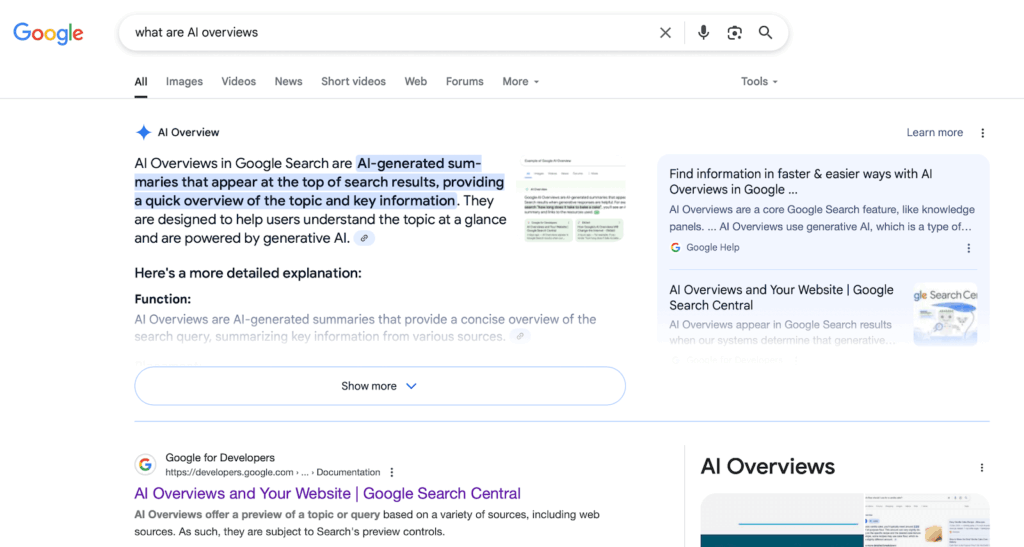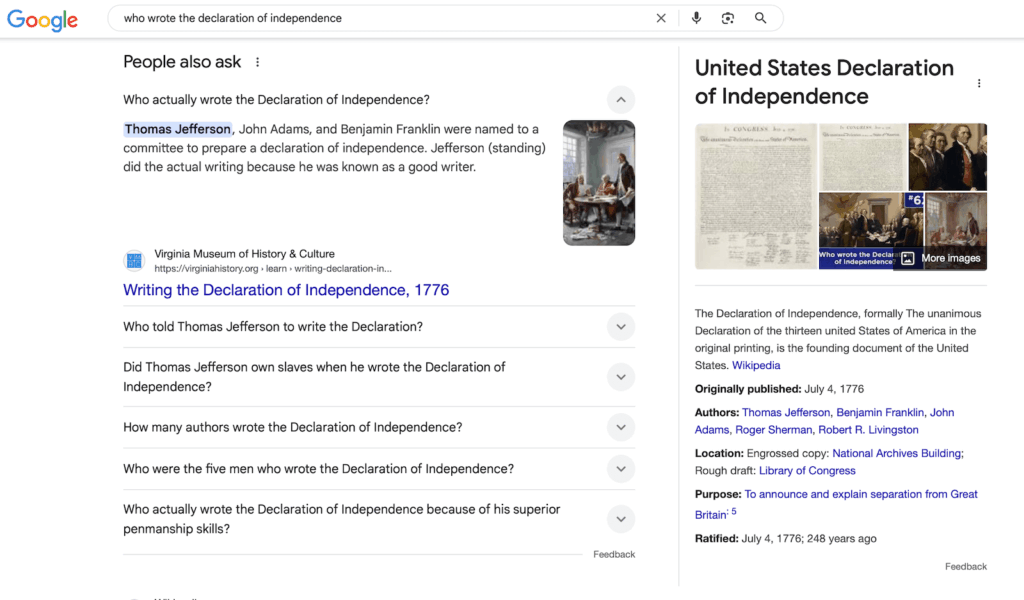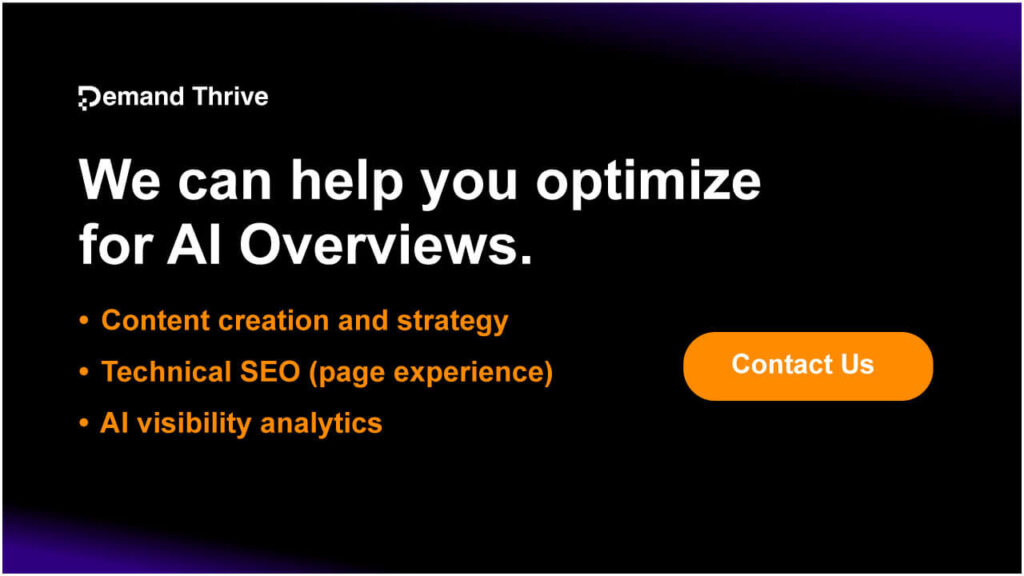(Last updated: June 8, 2025)
Google Search has forever changed thanks to artificial intelligence.
One major change in particular is the rise of AI Overviews, which are AI-generated summaries of information found at the top of a search results page.
AI Overviews have major implications, from transforming how we use Google to find information to how companies leverage SEO and content to grow.
My aim with this guide is to provide a comprehensive explanation of AI Overviews, including how they work, the benefits they bring, the challenges they face, their future, and how businesses should adapt their digital marketing strategies.
Table of Contents
- What are AI Overviews?
- How do AI Overviews Work?
- How do AI Overviews Differ From “Featured Snippets”?
- Benefits of AI Overviews
- Challenges of AI Overviews
- Adapting SEO Strategy for AI Overviews
What are AI Overviews?
AI Overviews are AI-generated summaries seen at the top of Google search results. They’re designed to provide quick answers to a person’s query and enhance search experience.

Recent studies by SEO technology companies like Semrush and SE Ranking have found that nearly 30% of search queries trigger AI Overviews, which is something I recently wrote about.
That’s a big number already, and it’s expected to increase rapidly.
As far as their formatting goes, AI Overviews typically contain a paragraph at the top followed by a “more detailed breakdown” below with bulleted points of information.
Link icons are often included at the end of sentences, which are hyperlinked to the sources the AI used to generate the summary.
How do AI Overviews Work?
AI Overviews work via a three step process:
- Input (query)
- Processing (generative AI, machine learning, natural language)
- Output (AI-generated summary plus links)
The AI Overview process begins with a person typing a query into Google Search (input). Then, Google Gemini (Google’s LLM, like ChatGPT) learns structures from the data to generate something new.
It analyzes various sources, identifies and extracts key information from them, and then synthesizes that information to prepare an answer. That synthesized answer is the overview, which is the output of the process.
As mentioned earlier, the output contains links to some of the sources used for the AI-generated answer, and the overview is often formatted with bold text and well-organized headings to maximize readability.

How do AI Overviews Differ From Featured Snippets?
You may be familiar with “featured snippets,” a search results feature Google deployed several years ago.
They are similar to AI Overviews, but the key difference is that AI Overviews pull information from a variety of sources and synthesize it to form summaries, while featured snippets extract information from a single webpage.
The formatting is different too, as featured snippets are listed in clickable, accordion-style headings.

Another important difference is that featured snippets are more geared towards answering specific and straightforward questions like, “who wrote the declaration of independence?”
AI Overviews, on the other hand, focus on providing comprehensive summaries (overviews) for more complex topics.
Benefits of AI Overviews
Users benefit in a variety of ways from AI Overviews, such as:
- Concise, easy-to-read answers
- Fast access to key information
- Instant links to important sources relevant to the query and answer
- Time-saving, as users don’t have to sift through links
All of these benefits improve the search experience, and that’s Google’s top priority.

Limitations of AI Overviews
AI Overviews have had some hiccups since their inception, including providing false and questionable information.
For example, AI Overviews have mistakenly suggested running with scissors is a useful exercise, as documented in this article by Search Engine Land.
More recently, several users noted that the query “is it 2025?” generated some incorrect results, with Google claiming that it was still 2024, as outlined in this Mashable article.
To add, there have even been some legal challenges to AI Overviews, particularly due to concerns that they significantly hurt website traffic while capitalizing on content created by others.
For example, Chegg, the education technology company, filed a lawsuit against Google last February, mentioning a loss in valuable website traffic due to Google’s AI-generated summaries.
Tips for Optimizing Your Content for AI Overviews
It’s important for any company invested in digital marketing to take AI Overviews seriously, and there are several steps your company can take to optimize content for AI and boost your chances of visibility.
Here are 3 tips for maximizing content visibility in AI Overviews:
- Create unique and valuable content for humans
- Maximize page experience for your users
- Make sure Google Search can access your content
1. Create Unique and Valuable Content for Humans
Creating unique and valuable content for humans has been a staple of any successful SEO and digital marketing strategy for companies, and that step is a key ingredient for success in AI Overviews.
For years, Google has focused on “rewarding” the content it thinks is the best match to someone’s query because that’s their goal – to bring the best content to users in the fastest way possible.
The best content still wins today.
Content should always be made for humans, meaning it should be readable, valuable, and made with your audience in mind.
Shady SEO practices in the past, like keyword stuffing and spamming links, won’t get you results in AI Overviews or traditional SEO in today’s digital marketing landscape.
If you want to have some success in AI Overviews, your company needs to focus on creating great content that’s unique, valuable, and written for people.
2. Maximize Page Experience
Earlier this month, I wrote an article called, The Importance of Page Experience for SEO, in which I discussed the factors that go into page experience:
- Do your pages score well on Google’s Core Web Vitals metrics?
- Are the pages of your website secure?
- Does your website display well on mobile devices?
- Is your content affected by overuse of ads that distract users?
Maximizing the list above boosts your chances of content visibility in AI Overviews, AI Search, and Search in general.
3. Ensure Google can Access Your Content
If Google can’t access your content, it won’t get indexed, and therefore won’t ever be served to users in search results.
The same can be applied to AI Overviews. No access to your site, no citation in AI Overviews.
Google’s bots crawl websites automatically, but if you want to take a deeper dive into how Google sees your website (or if it’s even doing so), be sure to use Google’s URL Inspection tool.

In Closing
AI Overviews provide quick, concise answers to search queries by analyzing data from a variety of sources.
They are located above traditional search results and contain links to sources that the AI used to generate the summary.
It’s important for modern marketing strategies to incorporate content optimization for AI Overviews because citation in them provides big opportunities for website traffic, lead generation, and brand awareness.
Around 30% of search queries currently trigger AI Overviews, with that number expected to rise rapidly, as mentioned earlier. That’s significant.
AI Overviews – Frequently Asked Questions
To determine if your content is cited in AI Overviews, you can:
- use Google in Incognito mode in Chrome or (Private mode in Safari), and search for specific topics you’re trying to rank for and see if your website is cited
- use a platform like Semrush or Ahrefs and use Position Tracking to determine visibility in AI Search
- You can track traffic from AI Overviews in Google Analytics 4
Yes, small businesses can absolutely compete in AI search. Here’s a quick customer success story. We helped a data analytics consultancy appear in AI Search (Microsoft Copilot) for a specific type of consulting service (thanks to great SEO and content). Our client acquired a new customer because their services were recommended by Copilot. It’s possible!
AI Overviews were launched in May 2024. They were originally a part of what Google called “Search Generative Experience” (SGE) but then rebranded to AI Overviews.
Do You Need Help Optimizing for AI Overviews?
If you need help creating and optimizing content to boost visibility in AI Overviews, we can help! Contact us today.


